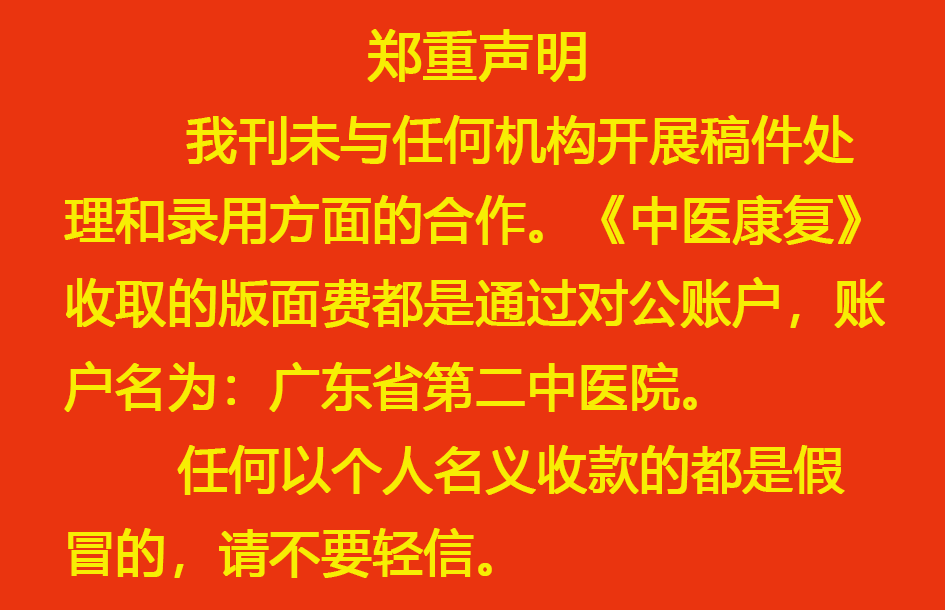| 摘要: |
| 目的:采用倾向评分回归调整(PSRA)均衡基线资料,比较艾灸同一穴位(上印堂)不同灸感(热敏灸态vs静息态)治 疗常年变应性鼻炎(PAR)灸效差异。方法:采用前瞻性队列研究设计,纳入 106例合格受试者,用艾条悬灸上印堂激发灸感, 根据热敏灸感的有无,自然分组为热敏灸组(n=69)和传统灸组(n=37)。 两组均在上印堂施灸,每次时间为 30min,每天 1 次, 连续四周,共计 24次。结局指标为变异性鼻炎症状量表(TNSS)、伴随症状量表(TNNSS)以及生存质量调查问卷(RQLQ)。 结果:使用PSM 进行 1:1配对,匹配容差 0.02,成功匹配 25对,共 50例患者。两组患者基线资料均无统计学差异(P>0.05)。 匹配后,治疗后热敏态组 TNSS评分为 4.01± 1.52,低于静态组的 5.42± 1. 10,有统计学意义(P<0.01);热敏态组 TNNSS评分为 1.26±0.43,低于静态组的 1.52±0.50,有统计学意义(P<0.01);热敏态组RQLQ评分为 37.62±6.01,低于静态组的47.22±7.76,有 统计学意义(P<0.01);说明热敏灸组在改善PAR患者症状、体征和生活质量方面均有疗效优势。将倾向性评分匹配前单因素 分析具有差异的结果纳入进行多因素 logistic回归分析,结果显示,是否用药、病程为艾灸疗效的独立危险因素(P<0.05) 。结 论:艾灸热敏态穴位治疗PAR的临床疗效优于静息态组。 |
| 关键词: 艾灸 常年变应性鼻炎 灸感与灸效 前瞻性队列研究 倾向评分回归调整(PSRA) |
| DOI:10. 19787/j.issn.2097-3128.2024.01.002 |
| 投稿时间:2023-04-21修订日期:2023-10-17 |
| 基金项目:江西省中医药管理局科技计划项目(2021A150) |
|
| Prospective Cohort Study on Moxibustion Sensation and Efficacy of Moxibustion in Treating Perennial Allergic Rhinitis Based on Propensity Score Regression Adjustment |
| XIONG Jun1,2, TANG Gen-hua1△, ZHANG Zheng2, LIAO Kai2, ZHOU Xiao-hong2, XU Ling-ling 2, LI Jun2, ZHOU Hai-ping2, XIANG Jie2 |
| (1. Jiangxi University of Chinese Medicine, Nanchang Jiangxi 330004;2. Affiliated Hospital of Jiangxi University of Chinese Medicine, Nanchang Jiangxi330006) |
| Abstract: |
| Objective: To compare the effect of moxibustion on perennial allergic rhinitis (PAR) with different moxibustion sensations (heat sensitive moxibustion vs resting moxibustion) at the same acupuncture point (Shangyitang) by using tendency score regression adjustment (PSRA) balanced baseline data. Methods: A prospective cohort study was designed and 106 qualified subjects were included. Moxibustion sensation was stimulated by moxibustion with moxibustion stick. According to the sensation of heat moxibustion, they were naturally divided into heat moxibustion group (n=69) and traditional moxibustion (n=37). Both groups were treated with moxibustion in Shangyin Tang for 30min each time, once a day for two weeks, a total of 12 times. The outcome measures were Variable rhinitis Symptom Scale (TNSS), concomitant Symptom Scale (TNNSS) and Quality of Life questionnaire (RQLQ). Result: PSM was used for 1 : 1 matching with a matching tolerance of 0.02, and 25 pairs were successfully matched with a to‐ tal of 50 patients. There was no significant difference in baseline data between the two groups (P>0.05). After matching, the TNSS score of the ther‐ mosensitive group after treatment was 4.01± 1.52, which was lower than that of the static group (5.42± 1. 10), with statistical significance (P<0.01). TNNSS score of the thermosensitive group was 1.26±0.43, which was lower than that of the static group ( 1.52±0.50), with statistical significance (P< 0.01). The RQLQ score of the thermal group was 37.62±6.01, which was lower than that of the static group (47.22±7.76), with statistical significance (P<0.01). This suggests that the static group has therapeutic advantages in improving symptoms, signs and quality of life in PAR patients. The results of univariate analysis with differences before propensity score matching were included in multivariate logistic regression analysis. The results showed that drug use and disease course were independent risk factors for the efficacy of moxibustion (P<0.05). Conclusion: The clinical effect of moxibustion heat sensitive acupoint therapy on PAR is better than that of rest state group. |
| Key words: oxibustion Perennial allergic rhinitis Moxibustion sensation and moxibustion effect Prospective cohort study Propensity Score Re‐ gression Adjustment (PSRA) |
